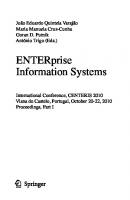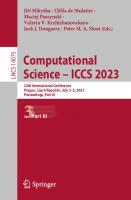Networked Digital Technologies, Part I: Second International Conference, NDT 2010, Prague, Czech Republic (Communications in Computer and Information Science, 87) 9783642142918, 3642142915
On behalf of the NDT 2010 conference, the Program Committee and Charles University in Prague, Czech Republic, we welcome
119 23 15MB
English Pages 603 [599] Year 2010
Table of contents :
Title Page
Preface
Organization
Table of Contents
Information and Data Management
A New Approach for Fingerprint Matching Using Logic Synthesis
Introduction of Biometrics and Fingerprint
Logic Synthesis
Minimization Method
Proposed Method
Conclusions
References
Extracting Fuzzy Rules to Classify Motor Imagery Based on a Neural Network with Weighted Fuzzy Membership Functions
Introduction
Overview of Motor Imagery Classification Model
Experimental Data
Wavelet-Based Feature Extraction
Neural Network with Weighted Fuzzy Membership Function (NEWFM)
Experimental Results
Concluding Remarks
References
Distributed Data-Mining in the LISp-Miner System Using Techila Grid
Introduction
LISp-Miner System
Techila Grid
Modifying Algorithm for Distributed Solving of Task
Previous Non-grid Implementation of Data-Mining Algorithm
Proposed Solution
Further Steps
References
Non-negative Matrix Factorization on GPU
Introduction
Non-negative Matrix Factorization
Computation Algorithms
GPU Utilization
Computation of NMF on GPU
Experimental Results
Results on Smaller Collection
Results on Larger Collection
Conclusion
References
Chatbot Enhanced Algorithms: A Case Study on Implementation in Bahasa Malaysia Human Language
Introduction
Chatbots Literature
ELIZA
A.L.I.C.E.
VPbot
Recap
New Enhanced Algorithms
Extension and Prerequisite
General Word Percentage (GWP)
Synonyms and Root-Words
Testing, Results and Discussions
Extension and Prerequisite
General Words Percentage (GWP)
Synonyms and Root-Words
Conclusion
References
Handwritten Digits Recognition Based on Swarm Optimization Methods
Introduction
The Multi-Layer Perceptron
The Bees’ Algorithm
The Artificial Bee Colony Optimization (ABC)
Problem Formulation
The Preprocessing Step
Features Extraction Step
The Classification Step
Results and Discussion
Conclusion
References
A Framework of Dashboard System for Higher Education Using Graph-Based Visualization Technique
Introduction
Related Works
Visual Data Mining
Data Visualization Technique and Software
Graph-Based Visualization Technique
Digital Dashboard
Data Visualization in Higher Education
The Framework of Dashboard System for Higher Education Environment
Framework Design
System Architecture
System Prototype
Health of the Institution at a Glance
Knowledge Exploration
Trend Analysis
Expert Opinion
Conclusion
References
An Efficient Indexing and Compressing Scheme for XML Query Processing
Introduction
Related Work
Structural Summary Indexing Methods
Structural Join Indexing Methods
Sequence-Based Indexing Methods
Overview of NCIM
The Methodology of NCIM
Query Processing in NCIM
Experimental Results
Datasets
Performance Analysis
Conclusions and Future Work
References
Development of a New Compression Scheme
Introduction
Current Related Work
Proposed Approach
Compression Process
Decompression Process
Performance Results
Discussion
Conclusions
References
Compression of Layered Documents
Introduction
SLIm
Don’t Care Pixels
A Software Tool for Layered Image Compression
Conclusions
References
Classifier Hypothesis Generation Using Visual Analysis Methods
Introduction
Related Work
Combined Approach
Document Preprocessing and Indexing
Hierarchical Clustering
Projection Algorithm
Multi-label Text Classification
Information Landscape
Classifier Visualisation
Interaction Mechanisms
UsageScenario
Discussion
Future Work
References
Exploiting Punctuations along with Sliding Windows to Optimize STREAM Data Manager
Introduction
Organization of the Paper
Related Work
Motivation
Analysis
Memory Resource Overhead
Blocking Operators
Join Operators
Overall Assessment
Future Work and Conclusion
References
A Framework for In-House Prediction Markets
Introduction
Brief Overview of Prediction Markets
A Framework for In-House Prediction Markets
Proposed Framework Principles
Conclusions and Future Work
References
Road Region Extraction Based on Motion Information and Seeded Region Growing for Foreground Detection
Introduction
Motion Trajectory Extraction
Seeded Region Growing
Experiment Results
Conclusion
References
Process Mining Approach to Promote Business Intelligence in Iranian Detectives` Police
Introduction
Police Detectives Roles
Process Mining: An Overview
Proposed Approach
Illustrative Example
Conclusion
References
Copyright Protection of Relational Database Systems
Introduction
Proposed Time Attribute-Based Watermarking
Watermark Embedding Procedure
Watermark Extraction Procedure
Performance Evaluation
Conclusions
References
Resolving Semantic Interoperability Challenges in XML Schema Matching
Introduction
Previous Approaches
Semantic Interoperability Challenges: Semantic Conflicts
Resolving Semantic Conflicts
Experiment and Results
Discussion and Conclusion
References
Some Results in Bipolar-Valued Fuzzy $BCK/BCI$-Algebras
Introduction
Preliminaries
Bipolar-Valued Fuzzy Subalgebras of $BCK$-Algebras
Conclusion
References
Security
The Effect of Attentiveness on Information Security
Introduction
Literature Review
Passwords and the Human Element
The Impact of the Human
The Meaning of Attentiveness
The Initial Experiment
Discussions and Conclusions
References
A Secured Mobile Payment Model for Developing Markets
Introduction
Proliferation of Mobile Payment Services
Introduction
Mobile Payment in Developed Countries
Mobile Payment in Developing Markets
Related Work
Security Concerns in Mobile Payment Systems
Mobile Payment Model for Developing Markets
Conclusion
References
Security Mapping to Enhance Matching Fine-Grained Security Policies
Introduction
Security Policies
WS-SecurityPolicy
Semantic Approaches
Fine-Grained Security Policy
Policy Attachment
The Need for Security Mapping
The Security Mapping Approach
Security Mapping Algorithm
Basic Security Mapping Operations
An Illustrative Example
Conclusion and Future Work
References
Implementation and Evaluation of Fast Parallel Packet Filters on a Cell Processor
Introduction
Specification of Filter Rules
Parallelized Packet Filters
Experimental Environment
Off-Line Experiments on a Virtual Network
Total Execution Time per Packet
Effective Filtering Time
Comparison to Other Processors
Experiments on a Real Network
Total Execution Time per Packet
Latency Time of Packet Filtering
Improving of SIMD Procedures
Future Works
References
On the Algebraic Expression of the AES S-Box Like S-Boxes
Introduction
Mathematical Background and Definitions
Algebraic Expression of Power Mapping Based S-Boxes
On the Complexity of the Proposed Method
Conclusions
References
Appendix: A
Student’s Polls for Teaching Quality Evaluation as an Electronic Voting System
Introduction
Traditional Polls
Authorization Separated from Identification
System with Remote Authorization
Anonymity with Blind Signature Protocol
Implementation Details and Conclusion
References
An Improved Estimation of the RSA Quantum Breaking Success Rate
Introduction
Shor’s Algorithm
Numerical Simulation
Results
Conclusion
References
Mining Bluetooth Attacks in Smart Phones
Introduction
Preliminaries
Bluetooth Attacks
Modeling the Attacks
Verifying Models
Mining Attacks
Mining Phone Call Initiation Attack
Related Works
Conclusion
References
Users’ Acceptance of Secure Biometrics Authentication System: Reliability and Validate of an Extended UTAUT Model
Introduction
Research Model Development
Experimental and Measurement Development
Reliability and Validation of the Measurement Scale
Discussion and Conclusion
References
Two Dimensional Labelled Security Model with Partially Trusted Subjects and Its Enforcement Using SELinux DTE Mechanism
Introduction
Security Model
Information Flow Policy
Security Properties of the Information Flow Policy
Comparison to Other Projects
Using SELinux to Enforce Our Policy
Some SELinux Basics
Configuring SELinux for Our Policy
Conclusions
References
A Roaming-Based Anonymous Authentication Scheme in Multi-domains Vehicular Networks
Introduction
Preliminary
Security Requirements
Network Model
Attack in Vehicular Networks
The Proposed Schemes
Polynomial-Pool Based Key Distribution
Our Schemes
Discussion
Security of the Proposed Schemes
Comparisons
Conclusions
References
Human Authentication Using FingerIris Algorithm Based on Statistical Approach
Introduction
Background
Biometric as Alternative of Password
Authentication Using Fingerprint and Iris Image
Fingerprint or Iris Image Processing
Matching Techniques
Methodology and Discussion
FingerIris Preprocessing
Matching Procedure
Testing Our System
Conclusion
References
Aerial Threat Perception Architecture Using Data Mining
Introduction
Proposed Model
Methodology
Results
Conclusion
References
Payload Encoding for Secure Extraction Process in Multiple Frequency Domain Steganography
Introduction
Related Studies
Research Methodology
The New Approach
Architecture of the Proposed System
The Security in the New Approach
Experiments Results
Conclusion and Future Works
References
An Implementation of Digital Image Watermarking Based on Particle Swarm Optimization
Introduction
Preliminaries
Discrete Wavelet Transform (DWT)
Particle Swarm Optimization (PSO)
The Proposed Scheme
Watermark Embedding
Watermark Extraction
Proposed Optimization Process
Experimental Results
Conclusions
References
Genetic Cryptanalysis
Introduction
SPN
GA Cryptanalysis
Experimental Results
Conclusions
References
Multiple Layer Reversible Images Watermarking Using Enhancement of Difference Expansion Techniques
Introduction
Enhancement Multilevel Difference Expansion (DE) Techniques
Multiple Layer of Reversible Watermarking Scheme
Principle
Lookup Table
Scanning and Embedding
Extraction and Recovery
Experimental Results and Comparisons
Experimental Results
Analysis
Comparisons with Other Algorithms
Conclusion
References
Modeling and Analysis of Reconfigurable Systems Using Flexible Nets
Introduction
Flexible Nets
Formal Definition
Firing Rules
A Case Study
Used Agents in the VHE
The Initialization Scenario
Connection Scenario for a Mobile Device
Analysis Issues
Related Works
Conclusion
References
Using Privilege Chain for Access Control and Trustiness of Resources in Cloud Computing
Introduction
JPEG Metadata
System-Context Information in Cloud Memories
Access Control Models
Policy Management
Privilege Chains
Trustiness of Cloud Resources
Authorization Decision
Conclusion
References
Social Networks
Modeling of Trust to Provide Users Assisted Secure Actions in Online Communities
Introduction
The Engine Ratings of Our Trust System
Example of Using StarWorth System
The Simulator
Tests
The Results of Using StarWorth System
Conclusions
References
A Collaborative Social Decision Model for Digital Content Credibility Improvement
Introduction
Social Network Intelligence
The Collaborative Social Decision Model for Leisure e-Service
Framework of CSDM on Leisure e-Service
Computational Designs for CSDM
Evaluation Design
Discussion
Customized Personal Service
Human Nature
Relationship Sensibility
Limitations and Assumptions
Conclusions
References
Improving Similarity-Based Methods for Information Propagation on Social Networks
Introduction
Node Similarity
Beyond the Similarity: The Expectation Notion
Experiments
Data Set
Measurements
Results
Conclusion and Future Work
References
Approaches to Privacy Protection in Location-Based Services
Introduction
Three Approaches to Privacy Protection in Location-Based Services
Privacy Parameters
Data Disclosure Control Algorithms
Information Architectures
Conclusions
References
Social Media as Means for Company Communication and Service Design
Introduction
Social Media in Company Communication
External Communication
Internal Communication
Potential of Social Media in Company Communication
Customer Involvement in Service Development
Utilizing Social Media in Service Development
Conclusions
References
A Problem-Centered Collaborative Tutoring System for Teachers Lifelong Learning: Knowledge Sharing to Solve Practical Professional Problems
Introduction
From the Needs to the TeTraKap Project
Principles of the Problem-Centered Module
General Model
Problem and Solution Description
Teacher Profile for Connecting People
Solution Appropriation and Feedback
Knowledge Indexing
Use Case
If No Similar Problem Exists…
If a Similar Problem Already Exists …
Discussion and Future Work
References
Bridging the Gap between Web 2.0 Technologies and Social Computing Principles
Introduction: The Theory-Technology Gap in Web 2.0
Related Literature on Web 2.0
Web 2.0: How Can It Be Defined?
Web 2.0 Technologies
Social Computing and Its Principles
Social Computing Principles
Technology Oriented
Socially Oriented
Mapping Web 2.0 Technologies and Principles
Conclusions
Discussion
References
Ontology
Using Similarity Values for Ontology Matching in the Grid
Introduction
Related Work
Ontology Matching
Using Similarity Values for Ontology Matching
Ontology Matching in a Grid Environment
Conclusions and Outlook
References
Rapid Creation and Deployment of Communities of Interest Using the CMap Ontology Editor and the KAoS Policy Services Framework
Introduction
Requirement Analysis of Communities of Interest Lifecycle
Exploration and Creation Phase Requirements for the COI-Tool
Implementation Phase Requirements for the COI-Tool
Operation, Monitoring and Maintenance Phase Requirements for the COI-Tool
COI-Tools Prototype as an Integration of Existing Systems
COE - CMap Ontology Editor
KAoS Policy Services Framework
AFRL Information Management System
COI-Tool Architecture and Functionality
COI-Tool Functionality for the COI Exploration and Creation Phase
COI-Tool Functionality for the Implementation Phase
COI-Tool Functionality for the Operation, Monitoring and Maintenance Phase
Proof of Concept – METOC Community of Interest
Conclusions
References
Incorporating Semantics into an Intelligent Clothes Search System Using Ontology
Background
Ontology Structure for Personal Digital Wardrobe
Attributes Extraction
Conclusion
References
SPPODL: Semantic Peer Profile Based on Ontology and Description Logic
Introduction
Related Works
Build SPPODL
The Conceptualization Step
Formalization Phase
Codification Phase
Verification Phase
Conclusion
References
Ontology Based Tracking and Propagation of Provenance Metadata
Introduction
Representation of Provenance Data in Ontologies
State of the Art
OWL DL Setting
Provenance Representation Pattern
Propagation of Provenance Metadata in Ontologies
Conclusions
References
Real Time Biometric Solutions for Networked Society
A Real-Time In-Air Signature Biometric Technique Using a Mobile Device Embedding an Accelerometer
Introduction
Analysis method proposed
Database Description
Experimental Results
Conclusion and Future Work
References
On-Demand Biometric Authentication of Computer Users Using Brain Waves
Introduction
Verification Using EEG in Mental Task
Brain Wave
Mental Task
Feature Extraction
Verification
Experiments
Conditions
Results
Conclusions
References
Encrypting Fingerprint Minutiae Templates by Random Quantization
Introduction
Proposed Method
Geometrical Alignment of Minutiae Vicinity
Random Quantization
Hash Length Tuning
Experimental Results
Security Analysis
Conclusions
References
Web Applications
Method for Countering Social Bookmarking Pollution Using User Similarities
Introduction
Analysis of Characteristics of SBM Pollution
Method for Countering SBM Pollution
Performance Evaluation
Conclusion and Future Work
References
A Human Readable Platform Independent Domain Specific Language for WSDL
Introduction
Related Work
SOAL for WSDL
Specification
Architecture
Evaluation
Summary
References
A Human Readable Platform Independent Domain Specific Language for BPEL
Introduction
Related Work
SOAL for BPEL
Specification
Correlations
Architecture
Summary
References
Impact of the Multimedia Traffic Sources in a Network Node Using FIFO scheduler
Introduction
Traffic Model and Simulation Considerations
Description of the Analyzed Scenarios
Analyses of Results
Conclusions
References
Assessing the LCC Websites Quality
Introduction
Web Sites Assessments Tools: A Review of the Literature
Research Framework and Methodology
LCC Website Index Development
Result Analysis
Conclusion and Future Work
References
Expediency Heuristic in University Conference Webpage
Introduction
Literature Review
Existing System
Methodology Development
Analysis
System Design
Interface Design
Result
Conclusion
References
Author Index
Title Page
Preface
Organization
Table of Contents
Information and Data Management
A New Approach for Fingerprint Matching Using Logic Synthesis
Introduction of Biometrics and Fingerprint
Logic Synthesis
Minimization Method
Proposed Method
Conclusions
References
Extracting Fuzzy Rules to Classify Motor Imagery Based on a Neural Network with Weighted Fuzzy Membership Functions
Introduction
Overview of Motor Imagery Classification Model
Experimental Data
Wavelet-Based Feature Extraction
Neural Network with Weighted Fuzzy Membership Function (NEWFM)
Experimental Results
Concluding Remarks
References
Distributed Data-Mining in the LISp-Miner System Using Techila Grid
Introduction
LISp-Miner System
Techila Grid
Modifying Algorithm for Distributed Solving of Task
Previous Non-grid Implementation of Data-Mining Algorithm
Proposed Solution
Further Steps
References
Non-negative Matrix Factorization on GPU
Introduction
Non-negative Matrix Factorization
Computation Algorithms
GPU Utilization
Computation of NMF on GPU
Experimental Results
Results on Smaller Collection
Results on Larger Collection
Conclusion
References
Chatbot Enhanced Algorithms: A Case Study on Implementation in Bahasa Malaysia Human Language
Introduction
Chatbots Literature
ELIZA
A.L.I.C.E.
VPbot
Recap
New Enhanced Algorithms
Extension and Prerequisite
General Word Percentage (GWP)
Synonyms and Root-Words
Testing, Results and Discussions
Extension and Prerequisite
General Words Percentage (GWP)
Synonyms and Root-Words
Conclusion
References
Handwritten Digits Recognition Based on Swarm Optimization Methods
Introduction
The Multi-Layer Perceptron
The Bees’ Algorithm
The Artificial Bee Colony Optimization (ABC)
Problem Formulation
The Preprocessing Step
Features Extraction Step
The Classification Step
Results and Discussion
Conclusion
References
A Framework of Dashboard System for Higher Education Using Graph-Based Visualization Technique
Introduction
Related Works
Visual Data Mining
Data Visualization Technique and Software
Graph-Based Visualization Technique
Digital Dashboard
Data Visualization in Higher Education
The Framework of Dashboard System for Higher Education Environment
Framework Design
System Architecture
System Prototype
Health of the Institution at a Glance
Knowledge Exploration
Trend Analysis
Expert Opinion
Conclusion
References
An Efficient Indexing and Compressing Scheme for XML Query Processing
Introduction
Related Work
Structural Summary Indexing Methods
Structural Join Indexing Methods
Sequence-Based Indexing Methods
Overview of NCIM
The Methodology of NCIM
Query Processing in NCIM
Experimental Results
Datasets
Performance Analysis
Conclusions and Future Work
References
Development of a New Compression Scheme
Introduction
Current Related Work
Proposed Approach
Compression Process
Decompression Process
Performance Results
Discussion
Conclusions
References
Compression of Layered Documents
Introduction
SLIm
Don’t Care Pixels
A Software Tool for Layered Image Compression
Conclusions
References
Classifier Hypothesis Generation Using Visual Analysis Methods
Introduction
Related Work
Combined Approach
Document Preprocessing and Indexing
Hierarchical Clustering
Projection Algorithm
Multi-label Text Classification
Information Landscape
Classifier Visualisation
Interaction Mechanisms
UsageScenario
Discussion
Future Work
References
Exploiting Punctuations along with Sliding Windows to Optimize STREAM Data Manager
Introduction
Organization of the Paper
Related Work
Motivation
Analysis
Memory Resource Overhead
Blocking Operators
Join Operators
Overall Assessment
Future Work and Conclusion
References
A Framework for In-House Prediction Markets
Introduction
Brief Overview of Prediction Markets
A Framework for In-House Prediction Markets
Proposed Framework Principles
Conclusions and Future Work
References
Road Region Extraction Based on Motion Information and Seeded Region Growing for Foreground Detection
Introduction
Motion Trajectory Extraction
Seeded Region Growing
Experiment Results
Conclusion
References
Process Mining Approach to Promote Business Intelligence in Iranian Detectives` Police
Introduction
Police Detectives Roles
Process Mining: An Overview
Proposed Approach
Illustrative Example
Conclusion
References
Copyright Protection of Relational Database Systems
Introduction
Proposed Time Attribute-Based Watermarking
Watermark Embedding Procedure
Watermark Extraction Procedure
Performance Evaluation
Conclusions
References
Resolving Semantic Interoperability Challenges in XML Schema Matching
Introduction
Previous Approaches
Semantic Interoperability Challenges: Semantic Conflicts
Resolving Semantic Conflicts
Experiment and Results
Discussion and Conclusion
References
Some Results in Bipolar-Valued Fuzzy $BCK/BCI$-Algebras
Introduction
Preliminaries
Bipolar-Valued Fuzzy Subalgebras of $BCK$-Algebras
Conclusion
References
Security
The Effect of Attentiveness on Information Security
Introduction
Literature Review
Passwords and the Human Element
The Impact of the Human
The Meaning of Attentiveness
The Initial Experiment
Discussions and Conclusions
References
A Secured Mobile Payment Model for Developing Markets
Introduction
Proliferation of Mobile Payment Services
Introduction
Mobile Payment in Developed Countries
Mobile Payment in Developing Markets
Related Work
Security Concerns in Mobile Payment Systems
Mobile Payment Model for Developing Markets
Conclusion
References
Security Mapping to Enhance Matching Fine-Grained Security Policies
Introduction
Security Policies
WS-SecurityPolicy
Semantic Approaches
Fine-Grained Security Policy
Policy Attachment
The Need for Security Mapping
The Security Mapping Approach
Security Mapping Algorithm
Basic Security Mapping Operations
An Illustrative Example
Conclusion and Future Work
References
Implementation and Evaluation of Fast Parallel Packet Filters on a Cell Processor
Introduction
Specification of Filter Rules
Parallelized Packet Filters
Experimental Environment
Off-Line Experiments on a Virtual Network
Total Execution Time per Packet
Effective Filtering Time
Comparison to Other Processors
Experiments on a Real Network
Total Execution Time per Packet
Latency Time of Packet Filtering
Improving of SIMD Procedures
Future Works
References
On the Algebraic Expression of the AES S-Box Like S-Boxes
Introduction
Mathematical Background and Definitions
Algebraic Expression of Power Mapping Based S-Boxes
On the Complexity of the Proposed Method
Conclusions
References
Appendix: A
Student’s Polls for Teaching Quality Evaluation as an Electronic Voting System
Introduction
Traditional Polls
Authorization Separated from Identification
System with Remote Authorization
Anonymity with Blind Signature Protocol
Implementation Details and Conclusion
References
An Improved Estimation of the RSA Quantum Breaking Success Rate
Introduction
Shor’s Algorithm
Numerical Simulation
Results
Conclusion
References
Mining Bluetooth Attacks in Smart Phones
Introduction
Preliminaries
Bluetooth Attacks
Modeling the Attacks
Verifying Models
Mining Attacks
Mining Phone Call Initiation Attack
Related Works
Conclusion
References
Users’ Acceptance of Secure Biometrics Authentication System: Reliability and Validate of an Extended UTAUT Model
Introduction
Research Model Development
Experimental and Measurement Development
Reliability and Validation of the Measurement Scale
Discussion and Conclusion
References
Two Dimensional Labelled Security Model with Partially Trusted Subjects and Its Enforcement Using SELinux DTE Mechanism
Introduction
Security Model
Information Flow Policy
Security Properties of the Information Flow Policy
Comparison to Other Projects
Using SELinux to Enforce Our Policy
Some SELinux Basics
Configuring SELinux for Our Policy
Conclusions
References
A Roaming-Based Anonymous Authentication Scheme in Multi-domains Vehicular Networks
Introduction
Preliminary
Security Requirements
Network Model
Attack in Vehicular Networks
The Proposed Schemes
Polynomial-Pool Based Key Distribution
Our Schemes
Discussion
Security of the Proposed Schemes
Comparisons
Conclusions
References
Human Authentication Using FingerIris Algorithm Based on Statistical Approach
Introduction
Background
Biometric as Alternative of Password
Authentication Using Fingerprint and Iris Image
Fingerprint or Iris Image Processing
Matching Techniques
Methodology and Discussion
FingerIris Preprocessing
Matching Procedure
Testing Our System
Conclusion
References
Aerial Threat Perception Architecture Using Data Mining
Introduction
Proposed Model
Methodology
Results
Conclusion
References
Payload Encoding for Secure Extraction Process in Multiple Frequency Domain Steganography
Introduction
Related Studies
Research Methodology
The New Approach
Architecture of the Proposed System
The Security in the New Approach
Experiments Results
Conclusion and Future Works
References
An Implementation of Digital Image Watermarking Based on Particle Swarm Optimization
Introduction
Preliminaries
Discrete Wavelet Transform (DWT)
Particle Swarm Optimization (PSO)
The Proposed Scheme
Watermark Embedding
Watermark Extraction
Proposed Optimization Process
Experimental Results
Conclusions
References
Genetic Cryptanalysis
Introduction
SPN
GA Cryptanalysis
Experimental Results
Conclusions
References
Multiple Layer Reversible Images Watermarking Using Enhancement of Difference Expansion Techniques
Introduction
Enhancement Multilevel Difference Expansion (DE) Techniques
Multiple Layer of Reversible Watermarking Scheme
Principle
Lookup Table
Scanning and Embedding
Extraction and Recovery
Experimental Results and Comparisons
Experimental Results
Analysis
Comparisons with Other Algorithms
Conclusion
References
Modeling and Analysis of Reconfigurable Systems Using Flexible Nets
Introduction
Flexible Nets
Formal Definition
Firing Rules
A Case Study
Used Agents in the VHE
The Initialization Scenario
Connection Scenario for a Mobile Device
Analysis Issues
Related Works
Conclusion
References
Using Privilege Chain for Access Control and Trustiness of Resources in Cloud Computing
Introduction
JPEG Metadata
System-Context Information in Cloud Memories
Access Control Models
Policy Management
Privilege Chains
Trustiness of Cloud Resources
Authorization Decision
Conclusion
References
Social Networks
Modeling of Trust to Provide Users Assisted Secure Actions in Online Communities
Introduction
The Engine Ratings of Our Trust System
Example of Using StarWorth System
The Simulator
Tests
The Results of Using StarWorth System
Conclusions
References
A Collaborative Social Decision Model for Digital Content Credibility Improvement
Introduction
Social Network Intelligence
The Collaborative Social Decision Model for Leisure e-Service
Framework of CSDM on Leisure e-Service
Computational Designs for CSDM
Evaluation Design
Discussion
Customized Personal Service
Human Nature
Relationship Sensibility
Limitations and Assumptions
Conclusions
References
Improving Similarity-Based Methods for Information Propagation on Social Networks
Introduction
Node Similarity
Beyond the Similarity: The Expectation Notion
Experiments
Data Set
Measurements
Results
Conclusion and Future Work
References
Approaches to Privacy Protection in Location-Based Services
Introduction
Three Approaches to Privacy Protection in Location-Based Services
Privacy Parameters
Data Disclosure Control Algorithms
Information Architectures
Conclusions
References
Social Media as Means for Company Communication and Service Design
Introduction
Social Media in Company Communication
External Communication
Internal Communication
Potential of Social Media in Company Communication
Customer Involvement in Service Development
Utilizing Social Media in Service Development
Conclusions
References
A Problem-Centered Collaborative Tutoring System for Teachers Lifelong Learning: Knowledge Sharing to Solve Practical Professional Problems
Introduction
From the Needs to the TeTraKap Project
Principles of the Problem-Centered Module
General Model
Problem and Solution Description
Teacher Profile for Connecting People
Solution Appropriation and Feedback
Knowledge Indexing
Use Case
If No Similar Problem Exists…
If a Similar Problem Already Exists …
Discussion and Future Work
References
Bridging the Gap between Web 2.0 Technologies and Social Computing Principles
Introduction: The Theory-Technology Gap in Web 2.0
Related Literature on Web 2.0
Web 2.0: How Can It Be Defined?
Web 2.0 Technologies
Social Computing and Its Principles
Social Computing Principles
Technology Oriented
Socially Oriented
Mapping Web 2.0 Technologies and Principles
Conclusions
Discussion
References
Ontology
Using Similarity Values for Ontology Matching in the Grid
Introduction
Related Work
Ontology Matching
Using Similarity Values for Ontology Matching
Ontology Matching in a Grid Environment
Conclusions and Outlook
References
Rapid Creation and Deployment of Communities of Interest Using the CMap Ontology Editor and the KAoS Policy Services Framework
Introduction
Requirement Analysis of Communities of Interest Lifecycle
Exploration and Creation Phase Requirements for the COI-Tool
Implementation Phase Requirements for the COI-Tool
Operation, Monitoring and Maintenance Phase Requirements for the COI-Tool
COI-Tools Prototype as an Integration of Existing Systems
COE - CMap Ontology Editor
KAoS Policy Services Framework
AFRL Information Management System
COI-Tool Architecture and Functionality
COI-Tool Functionality for the COI Exploration and Creation Phase
COI-Tool Functionality for the Implementation Phase
COI-Tool Functionality for the Operation, Monitoring and Maintenance Phase
Proof of Concept – METOC Community of Interest
Conclusions
References
Incorporating Semantics into an Intelligent Clothes Search System Using Ontology
Background
Ontology Structure for Personal Digital Wardrobe
Attributes Extraction
Conclusion
References
SPPODL: Semantic Peer Profile Based on Ontology and Description Logic
Introduction
Related Works
Build SPPODL
The Conceptualization Step
Formalization Phase
Codification Phase
Verification Phase
Conclusion
References
Ontology Based Tracking and Propagation of Provenance Metadata
Introduction
Representation of Provenance Data in Ontologies
State of the Art
OWL DL Setting
Provenance Representation Pattern
Propagation of Provenance Metadata in Ontologies
Conclusions
References
Real Time Biometric Solutions for Networked Society
A Real-Time In-Air Signature Biometric Technique Using a Mobile Device Embedding an Accelerometer
Introduction
Analysis method proposed
Database Description
Experimental Results
Conclusion and Future Work
References
On-Demand Biometric Authentication of Computer Users Using Brain Waves
Introduction
Verification Using EEG in Mental Task
Brain Wave
Mental Task
Feature Extraction
Verification
Experiments
Conditions
Results
Conclusions
References
Encrypting Fingerprint Minutiae Templates by Random Quantization
Introduction
Proposed Method
Geometrical Alignment of Minutiae Vicinity
Random Quantization
Hash Length Tuning
Experimental Results
Security Analysis
Conclusions
References
Web Applications
Method for Countering Social Bookmarking Pollution Using User Similarities
Introduction
Analysis of Characteristics of SBM Pollution
Method for Countering SBM Pollution
Performance Evaluation
Conclusion and Future Work
References
A Human Readable Platform Independent Domain Specific Language for WSDL
Introduction
Related Work
SOAL for WSDL
Specification
Architecture
Evaluation
Summary
References
A Human Readable Platform Independent Domain Specific Language for BPEL
Introduction
Related Work
SOAL for BPEL
Specification
Correlations
Architecture
Summary
References
Impact of the Multimedia Traffic Sources in a Network Node Using FIFO scheduler
Introduction
Traffic Model and Simulation Considerations
Description of the Analyzed Scenarios
Analyses of Results
Conclusions
References
Assessing the LCC Websites Quality
Introduction
Web Sites Assessments Tools: A Review of the Literature
Research Framework and Methodology
LCC Website Index Development
Result Analysis
Conclusion and Future Work
References
Expediency Heuristic in University Conference Webpage
Introduction
Literature Review
Existing System
Methodology Development
Analysis
System Design
Interface Design
Result
Conclusion
References
Author Index










